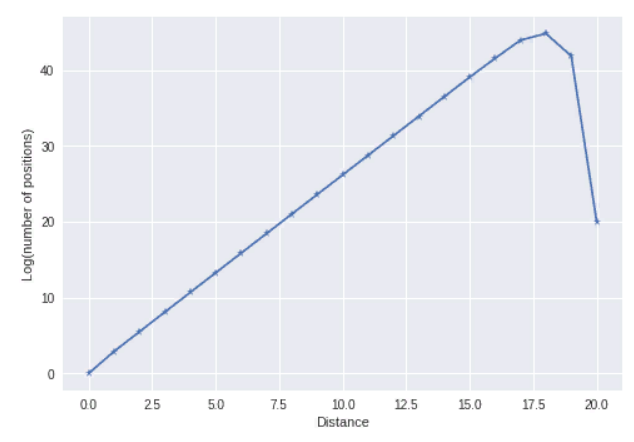Rubik's cube and its generalizations attracts certain attention of mathematical community. It is somehow "noteworthy" that it has been proved that diameter of the Rubik's cube group is 20, i.e. cubik can be turned into initial position at worst at 20 moves, it rises certain interesting questions e.g. MO139469.
It is not only the diameter has been calculated, but the position count for all distances presented. If one plots it at logarithmic scale one sees linear dependence almost everywhere:
So looking more carefully we see that number of positions at next step is approximately 13 times greater (see details below).
Question 1 Is there some explanation of such exponential grow ?
Question 2 What are the other examples of groups with similar growth pattern ?
Remarks: What seems puzzling for me, that exponential growth corresponds to (for example) for free group (obviously number of words of length n in k-letter alphabet is k^n), but for groups+generators which are similar to abelian groups the growth should be similar to normal distribution (a version of central limit theorem) - for example for $(Z/2Z)^n$ it corresponds to the setup of the most classical central limit theorem, which can be visualized by the Galton board (Bean machine). Similar results has been extented to permutation groups and metrics of them see MO320497. So it is somehow strange for me that Rubik's group+generators looks like free group, rather than abelian.
Datum (from http://www.cube20.org) + Pyhon code:
# Distance Count of Positions
datum =[ 0 , 1 ,
1 , 18 ,
2 , 243 ,
3 , 3240 ,
4 , 43239 ,
5 , 574908 ,
6 , 7618438 ,
7 , 100803036 ,
8 , 1332343288 ,
9 , 17596479795 ,
10 , 2.32248E+11 ,
11 , 3.06329E+12 ,
12 , 4.03744E+13 ,
13 , 5.31653E+14 ,
14 , 6.98932E+15 ,
15 , 9.13651E+16 ,
16 , 1.1E+18 ,
17 , 1.2E+19 ,
18 , 2.9E+19 ,
19 , 1.5E+18 ,
20 , 490000000 ]
import matplotlib.pyplot as plt
import numpy as np
plt.plot(np.log( datumCount),'*-' )
plt.xlabel('Distance')
plt.ylabel('Log(number of positions)')
plt.show()
datumCount = datum[1::2]
print( np.array(datumCount[1:])/np.array( datumCount[:-1]) )
[1.80000000e+01 1.35000000e+01 1.33333333e+01 1.33453704e+01
1.32960522e+01 1.32515776e+01 1.32314572e+01 1.32172933e+01
1.32071666e+01 1.31985490e+01 1.31897368e+01 1.31800776e+01
1.31680718e+01 1.31463944e+01 1.30721014e+01 1.20396081e+01
1.09090909e+01 2.41666667e+00 5.17241379e-02 3.26666667e-10]

